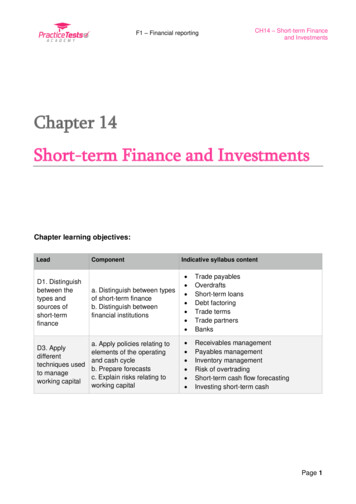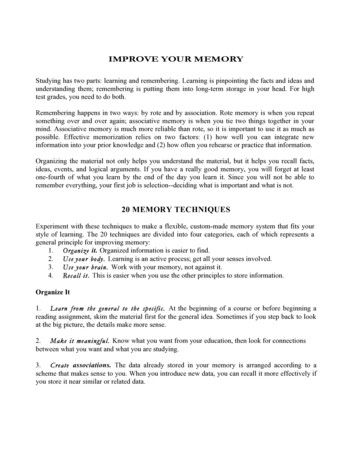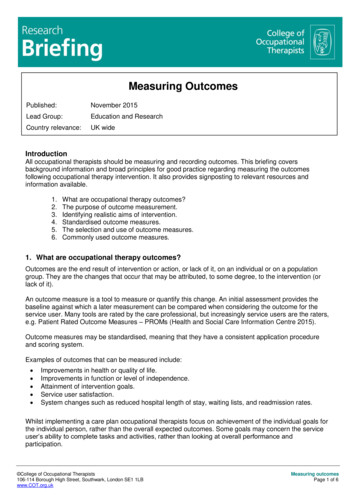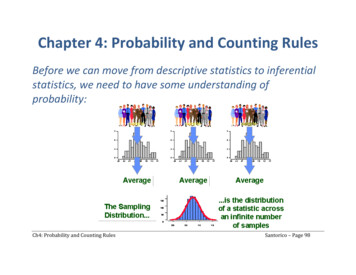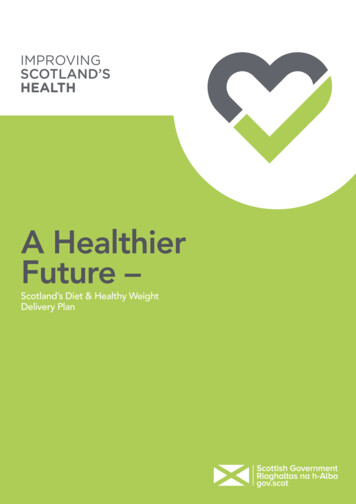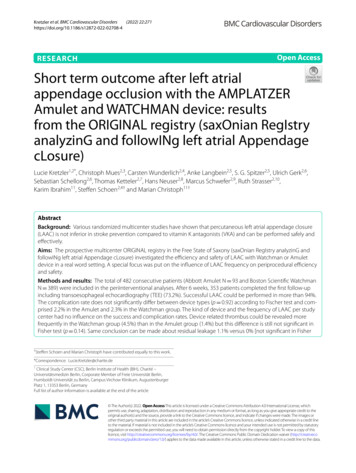
Transcription
(2022) 22:271Kretzler et al. BMC Cardiovascular 4Open AccessRESEARCHShort term outcome after left atrialappendage occlusion with the AMPLATZERAmulet and WATCHMAN device: resultsfrom the ORIGINAL registry (saxOnian RegIstryanalyzinG and followINg left atrial AppendagecLosure)Lucie Kretzler1,2*, Christoph Mues2,3, Carsten Wunderlich2,4, Anke Langbein2,5, S. G. Spitzer2,5, Ulrich Gerk2,6,Sebastian Schellong2,6, Thomas Ketteler2,7, Hans Neuser2,8, Marcus Schwefer2,9, Ruth Strasser2,10,Karim Ibrahim11, Steffen Schoen2,4† and Marian Christoph11†AbstractBackground: Various randomized multicenter studies have shown that percutaneous left atrial appendage closure(LAAC) is not inferior in stroke prevention compared to vitamin K antagonists (VKA) and can be performed safely andeffectively.Aims: The prospective multicenter ORIGINAL registry in the Free State of Saxony (saxOnian RegIstry analyzinG andfollowINg left atrial Appendage cLosure) investigated the efficiency and safety of LAAC with Watchman or Amuletdevice in a real word setting. A special focus was put on the influence of LAAC frequency on periprocedural efficiencyand safety.Methods and results: The total of 482 consecutive patients (Abbott Amulet N 93 and Boston Scientific WatchmanN 389) were included in the periinterventional analyses. After 6 weeks, 353 patients completed the first follow-upincluding transoesophageal echocardiography (TEE) (73.2%). Successful LAAC could be performed in more than 94%.The complication rate does not significantly differ between device types (p 0.92) according to Fischer test and comprised 2.2% in the Amulet and 2.3% in the Watchman group. The kind of device and the frequency of LAAC per studycenter had no influence on the success and complication rates. Device related thrombus could be revealed morefrequently in the Watchman group (4.5%) than in the Amulet group (1.4%) but this difference is still not significant inFisher test (p 0.14). Same conclusion can be made about residual leakage 1.1% versus 0% [not significant in Fisher†Steffen Schoen and Marian Christoph have contributed equally to this work.*Correspondence: Lucie.Kretzler@charite.de1Clinical Study Center (CSC), Berlin Institute of Health (BIH), Charité –Universitätsmedizin Berlin, Corporate Member of Freie Universität Berlin,Humboldt-Universität zu Berlin, Campus Virchow Klinikum, AugustenburgerPlatz 1, 13353 Berlin, GermanyFull list of author information is available at the end of the article The Author(s) 2022. Open Access This article is licensed under a Creative Commons Attribution 4.0 International License, whichpermits use, sharing, adaptation, distribution and reproduction in any medium or format, as long as you give appropriate credit to theoriginal author(s) and the source, provide a link to the Creative Commons licence, and indicate if changes were made. The images orother third party material in this article are included in the article’s Creative Commons licence, unless indicated otherwise in a credit lineto the material. If material is not included in the article’s Creative Commons licence and your intended use is not permitted by statutoryregulation or exceeds the permitted use, you will need to obtain permission directly from the copyright holder. To view a copy of thislicence, visit http:// creat iveco mmons. org/ licen ses/ by/4. 0/. The Creative Commons Public Domain Dedication waiver (http:// creat iveco mmons. org/ publi cdoma in/ zero/1. 0/) applies to the data made available in this article, unless otherwise stated in a credit line to the data.
Kretzler et al. BMC Cardiovascular Disorders(2022) 22:271Page 2 of 10test (p 0.26)]. Dual antiplatelet therapy followed the intervention in 64% and 22% of patients were discharged undera combination of an anticoagulant (VKA/DOAC/Heparin) and one antiplatelet agent.Conclusions: The ORIGINAL registry supports the thesis from large, randomized trials that LAAC can be performedwith a very high procedural success rate in the everyday clinical routine irrespective of the used LAA device (Watchman or Amulet). The postprocedural antithrombotic strategy differs widely among the participating centers.Trial registration Name of the registry: "saxOnian RegIstry analyzinG and followINg left atrial Appendage cLosure", Trialregistration number: DRKS00023803; Date of registration: 15/12/2020 ’Retrospectively registered’; URL of trial registryrecord: https:// www. drks. de/ drks web/ navig ate. do? navig ation Id trial. HTML& TRIAL ID DRKS0 00238 03.Keywords: Left atrial appendage, Atrial fibrillation, Stroke prevention, Patient registryIntroductionInterventional left atrial appendage closure (LAAC) hasadvanced to a well-established alternative to oral anticoagulation for stroke prevention in patients with atrialfibrillation, especially in subjects who are not suitablefor systemic anticoagulation [1, 2]. Various randomizedmulticenter studies have shown that LAAC is not inferior in stroke prevention compared to VKA and can beperformed safely and effectively [3, 4]. Thus, the 2.3 Yearfollow-up data of the PROTECT AF study could demonstrate that the "local" strategy of left atrial appendageclosure is noninferior to "systemic" anticoagulation withwarfarin [4]. Furthermore, the subsequent PREVAILtrial showed a significantly improved procedural safetyin comparison to the PROTECT AF data [3]. Basedon these studies, the guidelines also support LAAC inpatients who are not suitable for OAC. However due tothe relatively small number of cases in the randomizedtrials, further clinical registries are desirable as additionalconfirmation of the randomized study data in everydayroutine. Therefore, the current study aimed to evaluatethe efficacy and safety of LAAC with the AMPLATZERAmulet and WATCHMAN Left Atrial Appendage Closure 2.5 generation device and focuses on the comparisonof the two different devices regarding the periproceduralas well as short-term outcome data. These data were analysed with respect to the number of procedures/year/participating study center.MethodsStudy designThe ORIGINAL regIstry (saxOnian RegIstry analyzinG and followINg left atrial Appendage cLosures)represents a multicenter prospective clinical registrycomprising nine hospitals in the Federal State of Saxony,Germany. The study was approved by the institutionalethical review board. All data were collected, managedand analysed at the Technische Universität Dresden andBerlin Institute of Health at Charité – Universitätsmedizin Berlin (ethics approval: University of Dresden: EK245062014).Trial registration: Name of the registry: "saxOnian RegIstry analyzinG and followINg left atrial Appendage cLosure", Trial registration number: DRKS00023803; Date ofregistration: 15/12/2020 ’Retrospectively registered’; URLof trial registry record: https:// www. drks. de/ drks web/ navig ate. d o? n avig ation Id t rial. H TML& T RIAL I D DRKS0 00238 03The primary efficiency endpoint of current analysis wasthe proportion of successful LAA closure in dependenceof the used device (Amplatzer Amulet LAA Occluder;WATCHMAN Left Atrial Appendage Closure 2.5 generation device) and in dependence of the number of procedures performed annually per participating study center.The secondary efficiency endpoints included total procedure time, the fluoroscopy time, contrast agent consumption during LAAC and the number of mismeasureddiscarded devices in dependence of the used device andin dependence of the number of procedures performedannually per study center. Furthermore, the proportionof devices with a residual leakage 5 mm 6 weeks afterLAAC were recorded.The primary safety endpoint of current analysis wasthe occurrence of periinterventional complications during LAAC (pericardial effusion, thromboembolic events,access complications, device dislocation, and death).The secondary safe
and the signicance level was set to p .05/39 0.0013. Results Study population In total 482 consecutive patients were included in the periinterventional analysis. Both treatment groups (AMPLATZER Amulet N 93 and WATCHMAN Left Atrial Appendage Closure 2.5 generation device N 389) were balanced regarding the demographics and clinical




